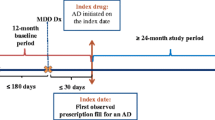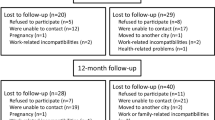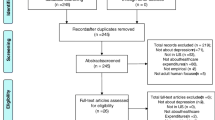Abstract
Understanding subsequent costs of treating patients who fail initial treatment for depression is critical in cost-effectiveness analysis. This prospective observational study calculated such costs in a community mental health center. Total mean annual direct per-patient costs were $6,818 to $8,661. This total was markedly higher than those reported in studies that were based partially on the assumptions of expert panels rather than observed utilization rates. These results suggest that in settings similar to the present study, antidepressant treatments with higher failure rates may carry a marked hidden cost disadvantage.
Similar content being viewed by others
REFERENCES
1997 Laboratory Fee Schedule. (1996, December). Medicare News, 31, 1–7.
Boyer, W.F., & Feighner, J.P. (1993). The financial implications of starting treatment with a selective serotonin reuptake inhibitor or tricyclic antidepressant in drug-naive depressed patients. In B. Jonsson & J. Rosenbaum (Eds.), Health Economics of Depression. Chichester, England: John Wiley & Sons.
Cardinale, V. (Ed.). (1997). 1997 Drug Topics Red Book. Montvale, NJ: Medical Economics Company.
First, M.B., Spitzer, R.L., Gibbon, M., & Williams, J.B.W. (1995). Structured Clinical Interview for DSM-IV Axis I Disorders-Patient Edition (SCID-I/P, Version 2.0).
Greenberg, P.E., Stiglin, L.E., Finkelstein, S.N., & Berndt, E.R. (1993). The economic burden of depression in 1990. Journal of Clinical Psychiatry, 54, 405–418.
Hamilton, M.A. (1960). A rating scale for depression. Journal of Neurology, Neurosurgery and Psychiatry, 23, 56–62.
Hylan, T.R., Kotsanos, J.G., Andersen, J.S., Brown, S.H., Merriman, C., Davis, L., Heiligenstein, J.H., Overhage, M., & Whiteside, R.E. (1996). Comparison of a decision analytic model with results from a naturalistic economic trial: An application to evaluating alternative antidepressants. The American Journal of Managed Care, 2(9), 1211–1223.
Jonsson, B., & Bebbington, P. (1994). What price depression? The cost of depression and the costeffectiveness of pharmacological treatment. British Journal of Psychiatry, 164, 665–673.
Kind, P., & Sjorensen, J. (1995). Modelling the cost-effectiveness of the prophylactic use of SSRIs in the treatment of depression. International Clinical Psychopharmacology, 10(suppl.), 41–48.
Lapierre, Y., Bentkover, J., Schainbaum, S., & Manners, S. (1995). Direct cost of depression: Analysis of treatment costs of paroxetine versus imipramine in Canada. Canadian Journal of Psychiatry, 40, 370–377.
Le Pen, C., Levy, E., Ravily, V., Beuzen, J.N., & Meurgey, F. (1994). The cost of treatment dropout in depression: A cost-benefit analysis of floxetine vs. tricyclics. Journal of Affective Disorders, 31, 1–18.
McCombs, J.S., Nichol, M.B., Stimmel, G., Sclar, D.A., Beasley, C.M., & Gross, L.S. (1990). The cost of antidepressant drug therapy failure: A study of antidepressant use patterns in a Medicaid population. Journal of Clinical Psychiatry, 51(suppl. 6), 60–69.
McFarland, B.H. (1994). Cost-effectiveness considerations for managed care systems: Treating depression in primary care. [Review]. American Journal of Medicine, 97(6A), 57S-58S.
Montgomery, S.A., Brown, R.E., & Clark, M. (1996). Economic analysis of treating depression with nefazadone v. imipramine. British Journal of Psychiatry, 168, 768–771.
Murray, C.L., & Lopez, A.D. (Eds.). (1996). The Global Burden of Disease, Vol. 1. Cambridge, MA: Harvard University Press.
Narrow, W.E., Regier, D.A., Rae, D.S., Manderscheid, R.W., & Locke, B.Z. (1993). Use of services by persons with mental and addictive disorders: Findings from the National Institute of Mental Health Epidemiologic Catchment Area Program. Archives of General Psychiatry, 50(2), 95–107.
Nuijten, M.J.C., Hardens, M., & Souetre, E. (1995). A Markov process analysis comparing the cost effectiveness of maintenance therapy with citalopram versus standard therapy in major depression. PharmacoEconomics, 8(2), 159–168.
PPRC. (1994). Chapter 18 Access for Medicaid Beneficiaries. Physician Payment Review Commission, Annual Report to Congress 1994. Washington, D.C.
Revicki, D.A., Brown, R.E., Keller, M.B., Gonzales, J., Culpepper, L., & Hales, R.E. (1997). Cost-effectiveness of newer antidepressants compared with tricyclic antidepressants in managed care settings. Journal of Clinical Psychiatry, 58(2), 47–58.
Revicki, D.A., Brown, R.E., Palmer, W., Bakish, D., Rosser, W.W., Anton, S.F., & Feeny, D. (1995). Modelling the cost effectiveness of antidepressant treatment in primary care. PharmacoEconomics, 8(6), 524–540.
Sledge, W.H., Tebes, J., Wolff, N., & Helminiak, T.W. (1996). Day hospital crisis respite care versus inpatient care. 2. Service utilization and costs. American Journal of Psychiatry, 153, 1074–1083.
Stewart, A. (1994). Antidepressant pharmacotherapy: Cost comparison of SSRIs and TCAs. British Journal of Medical Economics, 7, 67–79.
Thase, M.E., & Rush, A.J. (1995). Treatment-resistant depression. In F.E. Bloom & D.J. Kupfer (Eds.), Psychopharmacology: The Fourth Generation of Progress (pp. 1081–1097). New York: Raven Press.
Wells, K.B., Sturm, R., Sherbourne, C.D., & Meredith, L.S. (1996). Caring for Depression. Cambridge, MA: Harvard University Press.
Wells, K.B., Willard, G.M., Duan, N., Newhouse, J.P., & Ware, J.E. (1987). Cost-sharing and the use of general medical physicians for outpatient mental health care. Health Services Research, 22(1), 1–18.
Woods, S.W., & Baker, C.B. (1997). Cost-effectiveness of newer antidepressants. Current Opinion in Psychiatry, 10, 95–101.
Woods, S.W., & Baker, C.B. (in press). Cost effectiveness of the newer generation of antidepressants.In K. L. Davis, J. Coyle, C. B. Nemeroff, & D. S. Charney (Eds.), Psychopharmacology: The fifth generation of progress. New York: Raven Press.
Woods, S.W., & Rizzo, J.A. (1997). Cost-effectiveness of antidepressant treatment reassessed. British Journal of Psychiatry, 170, 257–263.
Author information
Authors and Affiliations
Rights and permissions
About this article
Cite this article
Baker, C.B., Woods, S.W. Cost of Treatment Failure for Major Depression: Direct Costs of Continued Treatment. Adm Policy Ment Health 28, 263–277 (2001). https://doi.org/10.1023/A:1011133529649
Issue Date:
DOI: https://doi.org/10.1023/A:1011133529649




